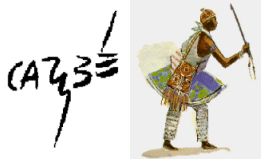Remembering a Friend
When I awoke on October 2, 1997, my 8-year-old daughter broke
the news. Carybé had died of respiratory heart failure the night before. He
was attending a meeting of the obás of the Candomblé
temple Ilę
Axé Opô Afonjá. Although he was attended by a doctor
on the way to a nearby hospital, he was pronounced dead on arrival. These
are the cold and clinical details. The fact is that, from one day to another,
a dear friend had gone, and the pain of that loss has dulled but not lessened
nearly one year after his passing.

Carybé where he most loved to be--
in
his studio.
Who was Carybé? If you live in Bahia,
you know the answer. Carybé was an artist who adopted this part
of Brazil as his home -- and was adopted by it. His works portrayed the
color, mysticism and sensuality of this place, with its unique blend of
European, African and Amerindian cultures.
When he first arrived here in 1938, he had lived in and visited
many countries and regions (including Argentina, where he was born, Italy,
his father's homeland, and Brazil, his mother's country). But Bahia bewitched
him. In 1950, he settled here permanently, with his Argentine wife, Nancy, and their 3-year-old son Ramiro.
Something similar happened to me. The difference being that I first arrived in 1986 and never left. When I came here, I already
knew about Carybé from his reverent watercolors of Candomblé
and its divinities, or orishas (in the first edition of African Gods in the Candomblé of Bahia),
and his dynamic pen-and-ink drawings of Capoeira. He was one of the two people
in Salvador I most wanted to meet (the other was Mother Stella of Oshossi, iyalorishá of Ilę Axé Opô Afonjá). The orishas granted both my wishes. Ashé!

A comprehensive look at his
life and work
Carybé's path converged with mine in two areas: publishing
and religion. I revised the translation of a huge tome on his life and
work in 1986, shortly after my daughter was born. As a result, I felt as
though I knew him and his family well, although I'd never met them. The
first time we did meet was at the launching of the book Bahias,
the first I actually translated.
I visited his house for the first time when escorting a visitor
from Nigeria (as an interpreter). I took the opportunity to ask him to
sign my copy of his book Carybé. He did, and painted a picture of Oshun on
the title page.

Oshun, as depicted by Carybé
in my copy of his book
Later, I often saw him and his wife, Nancy, and their daughter, Solange,
at the terreiro. There, I was dressed in the long skirt and head tie of
an abiyan, or novice Candomblé priestess.
Then, I was invited to translate the second edition of African
Gods in the Candomblé of Bahia. It was while working together
on this project that we finally became friends. His friendship is a gift I will
always treasure.
Browsing the Internet recently, I couldn't find any English-language
sites about Carybé and his work. This site is intended to rectify
that. Over time, I'll add biographical information and more reproductions of
some of his most representative works.
Eshú will take you back to my home page.











